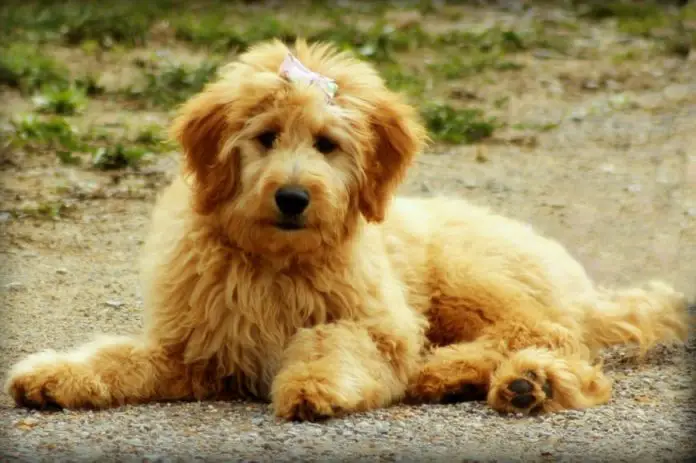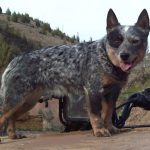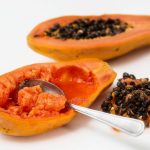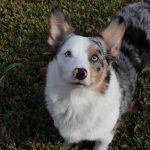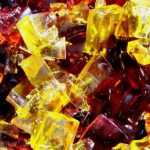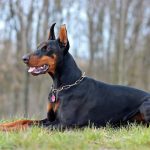Goldendoodle, one of the well-loved crossbreeds, is a combination of two dogs with different shedding levels. It is a cross between the Golden Retriever, a heavy shedder, and the Standard Poodle, a light shedder.
If you are planning to bring home a Goldendoodle, find out if you are going to deal with a great amount of pet hair at home or will have an easy time grooming your new pooch.
Types of Goldendoodle Coat
This designer breed does not have a single type of coat, which means these Doodle dogs have different shedding levels. You can find four types of coat from this cross.
It will take a year before you will see the true coat texture of your Goldendoodle. Get a comprehensive health evaluation from your prospect breeder to see if it is prone to allergies that often lead to uncontrolled shedding.
You can find Goldendoodles sporting a curly, straight, wavy, or an improper flat coat. This will depend on the “generation” of Goldendoodle you are planning to get.
- Curly – A curly Goldendoodle is a result of pairing two dogs with a curl gene. It is not prone to losing a lot of hair on a regular basis so it is the perfect choice for families with hypersensitivity to pet dander, since it does not shed a lot. If you prefer a pup with a curly coat, get a KRT71 gene test first from your prospect breeder.
- Straight – Straight-coated Goldendoodles are the result of breeding two dogs possessing the non-curl gene. They are expected to shed more compared to other types of Goldendoodles. If you prefer a pooch that has more of a Golden Retriever coat, this one may be the right choice for you.
- Improper flat – Goldendoodles with an improper flat coat have a resemblance to the Golden Retriever but without the furnishings or long hair around their face. Since it does not have a curly coat, it will be easy to groom. Brushing takes less time for this type of Doodle but expect it to shed to a certain degree.
- Wavy – these Goldendoodles are a combination of a curly and a non-curly dog. They could have hair around their face. Many people prefer these types of Goldendoodle because they have a great balance of their parents’ features. They are also regarded as the F1 Goldendoodles.
Goldendoodle Generation Numbers
Every dog has a generation number. Purebred dogs are referred to as the P Generation. When two purebred dogs are combined, their offspring will be under the F Generation.
The first generation or F1 Goldendoodles are 50-50 Poodle and Golden Retriever. Their coat is shaggy and loose. Although they have the tendency to shed, this can be easily managed since it’s very minimal. Regular vacuuming and having a lint roller handy should keep pet hair away.
An F1 Goldendoodle may experience seasonal shedding but you will not see crazy amount of hair, like in the case of their Golden Retriever parent. This occurs during the spring and fall or during warmer months as the dog’s preparation when the weather changes.
When you mate two F1 Goldendoodles, you will get an F2 Goldendoodle. Because it is 62.5 percent Poodle and 37.5 percent Golden Retriever, you can expect to see more of the characteristics of the Poodle in this generation. It is mostly wavy or curly just like Poodles.
The good thing about Poodles is they have a single coat. This means they do not experience blowing of the coat which is normal among double-coated breeds.
As you can see, some pups inherit more of the Poodle gene while some get most of their traits from their Golden Retriever parent. There are also the so-called multi-generation pups, which are the result of pairing two Goldendoodle pups.
When you breed two F1B Goldendoodles, you will have a pup possessing 75-percent of the Poodle gene and 25-percent of the Golden Retriever gene. It has the least shedding level of all.
Goldendoodle: Hypoallergenic or Not?
A Goldendoodle is one of those crosses often regarded as hypoallergenic. There is a bit of misconception about this theory, since there is no such thing as a 100% hypoallergenic pet. Yes, you might have seen hairless ones but even these dogs will shed to a certain degree and could even cause allergies.
This is due to the fact that fur can attract mold spores and other potential causes of allergy, like pollen. When a certain substance triggers the immune system, it overreacts and we get symptoms of allergy, like runny noses and sneezing.
Shedding is a natural process every dog has to go through. The old or dead hair needs to be removed in order for new hair to grow. It also serves as their body’s protection because the fur is responsible for controlling their body temperature.
Did you know that it’s not pet hair that causes allergy symptoms to humans? It is the dander, saliva, and urine as well as the flakes coming from the skin attached to the fur that triggers allergic reactions in humans. Poodles don’t produce much dander but remember that they are still dogs that produce saliva and urine.
Dander refers to dead skin particles coming from dogs. It is a microscopic substance containing protein, although some types of dander are large enough to be seen without a microscope. It can get attached to surfaces like beddings and fabrics. It can linger in the air for a while and it can be a problem if you have asthma or allergies.
If you have a pet at home, it helps to have a HEPA air cleaner as it traps particles like dander and dust mites that usually cause allergy. Many vacuum cleaners these days also come with HEPA filters. Vacuuming regularly will be an effective way to avoid dander around the home.
After vacuuming, improve your quality of air with the help of allergy spray. It is best sprayed on surfaces that often attract dander, like carpets and upholstered furniture.
Causes of Excessive Shedding in Dogs
Goldendoodles only have low to moderate shedding. If you suspect your pet’s shedding is not normal, observe if it comes with other symptoms like inflammation, itching, and redness. Hair loss in canines can be related to any of the following conditions:
- Hormonal problems – hypothyroidism and hyperthyroidism, the abnormal production of the T4 and T3 hormones, are usually characterized by skin disease and excess shedding. Oral replacement hormone is given to dogs with thyroid problems. It is characterized by symmetrical loss of hair.
- Bacterial and fungal infections – pyoderma, a bacterial skin infection among canines, is characterized by hair loss, discharges, and scaling. It is characterized by hair loss in multiple areas. It is usually treated with antibiotics for a minimum of three weeks. A vet may also recommend topical medication containing benzoyl peroxide depending on the severity of the condition.
- Food allergy – proteins in food can cause allergy symptoms in dogs, including dairy, chicken, and beef. The only way to diagnose food allergy in canines is an elimination diet trial. This is the reason why allergies to foods are often difficult to diagnose. If it is confirmed that your pet’s shedding is food-related, your vet will recommend making simple changes to your dog’s diet.
- Kidney problem – one of the possible causes of abnormal shedding is kidney disease. It has many possible causes, including ingestion of antifreeze medications, tainted foods, and even dental disease. Dogs may also develop stones when they have a chronic bacterial infection.
- Alopecia – it has many possible causes but the most common reason why dogs develop this condition is because of mange. The hair loss is varied but it often looks asymmetrical. A dog’s hair loss can be reversed through topical ointments. If you are considering home remedies for dog alopecia, you may try applying apple cider vinegar on the affected area.
- Cancer – like humans, dogs can also have cancer. One kind of cancer that affects many breeds of canines is skin cancer. In addition to hair loss, the other symptoms are lumps that are ulcerated and look a lot like warts. Nutrition boosters like Vitamins C and E can help reverse cancer-related hair loss.
- Parasites – when dogs are infested with fleas and tick, they cannot help but scratch certain parts of the body. The uncontrolled scratching eventually results in hair loss. Fortunately, there are a number of products that can prevent fleas and ticks and they can be in the form of spray, shampoos, and tablets.
- Sebaceous Adenitis – it is a kind of inflammatory skin disease often affecting young and middle-aged canines. It is also fairly common among Standard Poodles. The cause is still unknown but it can be treated with keratolytic shampoos and emollient rinses.
Tips to Minimize Canine Shedding
- Brush regularly. Brushing helps get rid of dead skin cells and fur. When grooming your pet, it is recommended to do it outside so the pet hair will not be attached to your furniture or anywhere inside your home.
- Use a coat conditioner. Conditioning your pet’s fur makes it less prone to dryness that often leads to excess shedding. Many solutions you can find online are easy to use; all you have to do is wipe it on your pet’s coat.
- Supplement with healthy oils. Omega-3 and Omega-6 fatty acids can contribute to healthier skin and coat. It prevents skin problems that often lead to uncontrolled shedding. It also restores your pet’s shiny coat.
- Wash your pet with mild shampoo – Goldendoodles do not need frequent baths but when they do, they should only be washed using a mild product specially created for dogs.
- Give a flea preventive every month – flea-prevention products normally contain fipronil and s-methoprene as active ingredients. These substances kill fleas and other insects that can contribute to skin itching and hotspots.
- Offer foods rich in vitamins, minerals, and antioxidants. Lastly, a well-balanced and diet contribute to the optimum coat and skin condition of canines.
Important Reminders before Getting a Goldendoodle
Goldendoodles are expected to have the best of both breeds. They have a good balance of traits of the Golden Retriever and the Poodle. Do note, however, that these designer dogs do not have predictable traits like their purebred parents.
Hence, you cannot say a Goldendoodle pup will be 100% non-shedding just because it has the Poodle breed in its lineage. Likewise, there is no assurance that it will be more like the Golden Retriever pup. This will still depend on the generation number of the pet.
Practice diligence when buying a new Poodle cross, because you cannot expect all breeders to be ethical. It’s not bad to research on the Internet, as long as you verify it yourself personally. Inspect the facility and check the background of both the parents and ask for health testing of both the Golden Retriever and the Poodle.
Avoid puppy mills and breeders who cannot provide certifications of both the Goldendoodle’s parents. The pups should be given the appropriate vaccines and deworming for their age and should be health tested for possible hereditary conditions.
You can get more information about Goldendoodles from clubs like the Goldendoodle Association of North America and the Golden Retriever Club of America. There are also Facebook groups of Goldendoodle owners who can give you practical advice and insights when getting a new pup.
Conclusion
A Goldendoodle’s shedding is very minimal. With regular grooming, supplementing your pet with healthy oils, and vacuuming often, shedding should not be a problem. In case your pup’s shedding does not look normal and it is associated with other skin problems, immediately seek veterinary’s advice.






